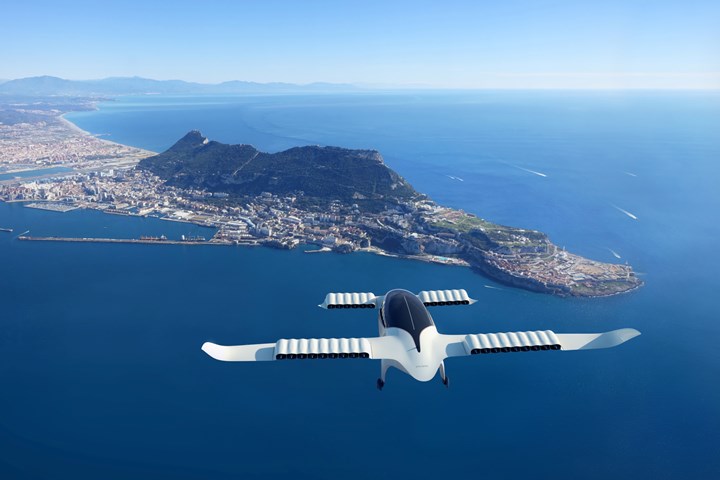Lilium expands on latest sourcing decision, go-to-market strategy
Lilium COO Yves Yemsi discusses the decision to source composite structures from Aeronnova and Aciturri, and how the company’s M&P choices might evolve.
Advanced air mobility (AAM) specialist Lilium (Munich, Germany) announced recently that it has chosen aerospace manufacturer Aeronnova Aerospace S.A. (Miñano Mayer, Spain) to design and manufacture the propulsion mounting system for the Lilium Jet eVTOL aircraft. This follows Lilium’s early 2021 announcement that Aciturri (Miranda de Ebro, Spain) had been chosen to fabricate primary composite and metallic structures for the Lilium Jet.
The Lilium Jet is being developed as a piloted, fixed-wing eVTOL air taxi with seating for up to four passengers. It is powered by 30 tilting ducted fans mounted on the leading edge of each wing and the horizontal tail fin. It’s designed for intercity service and has a physical range of 250 kilometers and a maximum cruising speed of up to 280 kilometers per hour. Lilium COO Yves Yemsi talked to CW about the choice of Aeronnova and how it fits with Lilium’s overall go-to-market strategy.
Yemsi says that, because Lilium is developing an aircraft for a new mobility marketplace, the company is keen to de-risk its structures fabrication by leveraging established aerospace supply chains. This means Lilium will, for its first-generation aircraft, depend on already-qualified materials (prepreg) and processes (hand layup, autoclave cure) deployed by vendors like Aeronnova and Aciturri, which have a long history serving the EU market. “We were looking for know-how and safety,” says Yemsi. “Our low-risk approach means we depend, initially, on the existing supply chain.”
The Lilium Jet propulsion mounting system, for example, says Yemsi, serves many functions, including blade containment, noise attenuation and support of the entire aircraft load during horizontal travel. In addition, each rotor is mounted within an aperture that must be fabricated to exact dimensions. Aeronnova’s strong engineering capabilities, says Yemsi, make the company well suited for the application.
Lilium, he adds, is close to completing primary design review on its first aircraft and will soon deliver the design to the company’s suppliers. Assembly of the first aircraft will follow, leading up to first flight. According to the AAM Reality Index, the Lilium Jet’s entry into service (EIS) is 2025.
Looking to the future, Lilium and Yemsi face many questions about structures fabrication. Assuming the Lilium Jet enters service and sees demand for the aircraft grow, the company conceivably will come up against the challenge of producing structures at a rate that cannot be met cost effectively using hand layup. At that point, the company may have to make some hard materials and process (M&P) choices. These choices may necessitate, Yemsi admits, development of a second-generation aircraft that will have to be separately certified. (Lilium is pursuing concurrent certification with the European Union Aviation Safety Agency (EASA) and the U.S. Federal Aviation Administration (FAA).)
Yemsi says he envisions moving toward automation and “getting away from hand layup” eventually, but he cannot commit completely to such a strategy. “Our shift to automation will be driven by the business case and cost effectiveness,” he says. “Each part will have its own shape, and that will dictate M&P. And in all cases, I think we will favor materials already qualified on other programs.”
What about thermoplastic composites and processes like resin transfer molding (RTM)? Yemsi’s view is that thermoplastics, at present, are not on Lilium’s radar. RTM, he says, is a feasible manufacturing process. He says he would not be surprised if Lilium’s second-generation aircraft was fabricated with some combination of hand layup, automation (ATL/AFP) and RTM. “A combination of technologies seems very possible to me,” he says.
The bottom line for Lilium and Yemsi is to follow a careful, deliberate path to aircraft development. This includes aerostructures. “I am now risk-averse,” Yemsi reiterates. “I don’t want to do R&D in the middle of the program. I want to go step by step and I want margins. When the Lilium Jet enters service, I want to feel confident that we did it the right way.”
Related Content
Welding is not bonding
Discussion of the issues in our understanding of thermoplastic composite welded structures and certification of the latest materials and welding technologies for future airframes.
Read MoreInfinite Composites: Type V tanks for space, hydrogen, automotive and more
After a decade of proving its linerless, weight-saving composite tanks with NASA and more than 30 aerospace companies, this CryoSphere pioneer is scaling for growth in commercial space and sustainable transportation on Earth.
Read MorePlant tour: Middle River Aerostructure Systems, Baltimore, Md., U.S.
The historic Martin Aircraft factory is advancing digitized automation for more sustainable production of composite aerostructures.
Read MoreThe potential for thermoplastic composite nacelles
Collins Aerospace draws on global team, decades of experience to demonstrate large, curved AFP and welded structures for the next generation of aircraft.
Read MoreRead Next
All-recycled, needle-punched nonwoven CFRP slashes carbon footprint of Formula 2 seat
Dallara and Tenowo collaborate to produce a race-ready Formula 2 seat using recycled carbon fiber, reducing CO2 emissions by 97.5% compared to virgin materials.
Read More“Structured air” TPS safeguards composite structures
Powered by an 85% air/15% pure polyimide aerogel, Blueshift’s novel material system protects structures during transient thermal events from -200°C to beyond 2400°C for rockets, battery boxes and more.
Read MoreVIDEO: High-volume processing for fiberglass components
Cannon Ergos, a company specializing in high-ton presses and equipment for composites fabrication and plastics processing, displayed automotive and industrial components at CAMX 2024.
Read More

























